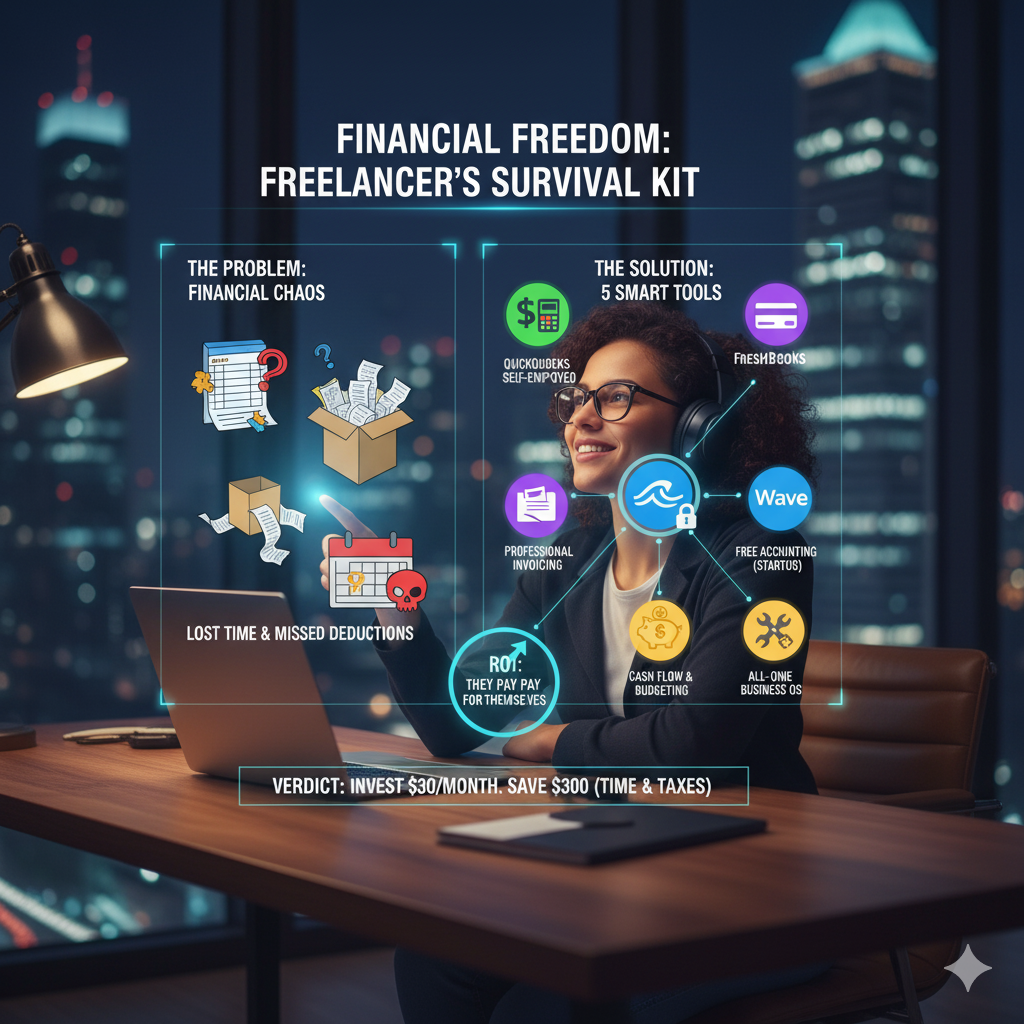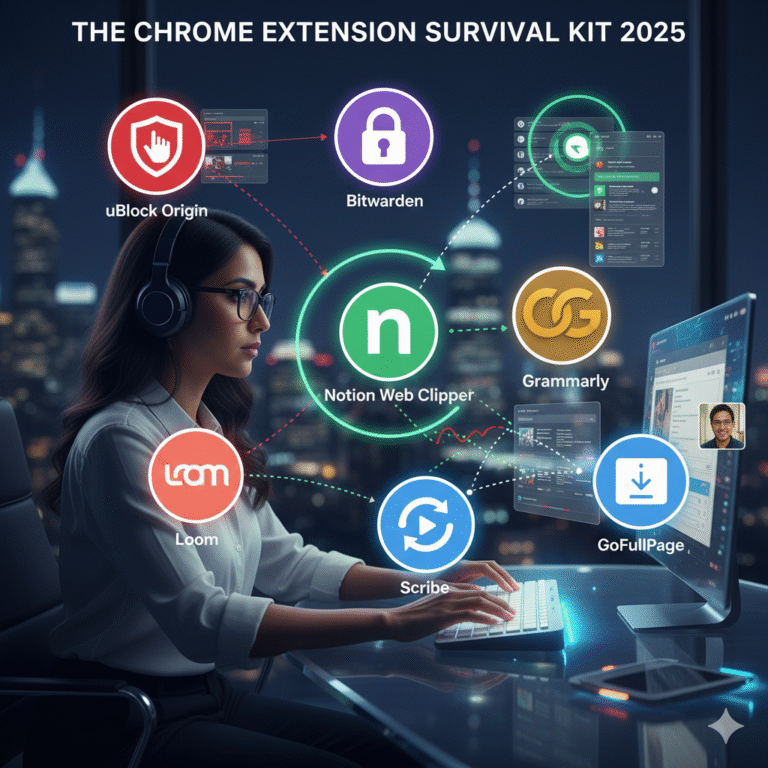The 5 Best Financial Control Tools for Freelancers & Sole Proprietors (And How They Pay for Themselves)
If you’re a freelancer or sole proprietor, this probably sounds familiar: you have a shoebox full of receipts, your invoices are a mix of Word docs and PDFs, you have no real idea what your “net profit” was last month, and the approaching tax season fills you with a special kind of dread.
This is “financial chaos.” It’s the default state for most independent professionals. We are experts at our *craft* (design, writing, coding) but amateurs at *business administration*. We often use a messy spreadsheet (or worse, our bank account) as our accounting system, which we call “good enough.”
This “good enough” approach is costing you thousands of dollars. It’s not just about stress; it’s about missed tax deductions, late payments from clients, and wasted, unbillable hours. This guide breaks down the 5 best financial control tools specifically for freelancers. We’ll show you why a $30/month tool is not a “cost”—it’s an investment that pays for itself in the first week.
Why Your Spreadsheet Is a “False Economy”
The #1 objection is “Why pay when Excel/Google Sheets is free?” This is a classic “false economy.” You are saving $30 in cash but losing $300 in time and errors.
Your spreadsheet can’t:
- Automatically connect to your bank and categorize expenses.
- Track your mileage for tax deductions.
- Create a professional, clickable invoice that a client can pay online.
- Show you a real-time Profit & Loss statement.
- Remind you (and your client) about an overdue invoice.
Your time is your most valuable asset. If you spend 4 hours a month “doing the books” manually, you’ve lost 4 billable hours. At $75/hour, that’s $300 in lost revenue to save $30. The math doesn’t work.
How These Tools Pay for Themselves (The ROI)
These tools aren’t “expenses”; they are “revenue-generators.”
- They Get You Paid Faster: Professional invoices with a “Pay Now” button (Stripe, PayPal) get paid an average of 10-15 days faster than a PDF attachment.
- They Recapture Lost Time: Automated invoicing, expense tracking, and reporting save you 5-10 hours of admin work per month. That is *billable time* you get back.
- They Maximize Tax Deductions: Tools like QuickBooks Self-Employed automatically track mileage and scan receipts. One single “missed” deduction for a $1,000 laptop or a year’s worth of mileage can cost you more in taxes than the tool’s 5-year subscription.
- They Eliminate “Late Payment” Anxiety: The system, not you, becomes the “bad guy,” sending polite, automated reminders to clients about overdue invoices.
The 5 Best Financial Tools for Freelancers
1. QuickBooks Self-Employed
Best for: The US-based (or global) freelancer whose #1 priority is *taxes*.
Why it wins: QuickBooks is the industry standard for a reason. The “Self-Employed” version is a simplified tool built for freelancers. Its superpower is tax preparation. It connects to your bank, lets you swipe “business” or “personal” on expenses (like Tinder for your finances), and automatically tracks mileage via your phone’s GPS. Come tax time, it generates the exact “Schedule C” reports your accountant needs. It’s a “tax-anxiety” killer.
2. FreshBooks
Best for: Service-based freelancers (designers, consultants, marketers) who need *professional invoicing*.
Why it wins: FreshBooks was built for *invoicing* first, and it shows. Its invoices are beautiful, easy to build, and packed with features. You can track your time *inside* FreshBooks and add it directly to an invoice, send automated late-payment reminders, and accept online payments. If your main financial friction is creating, sending, and chasing invoices, FreshBooks is your solution.
3. Wave
Best for: The new freelancer on a tight budget.
Why it wins: Its core features are 100% free. This is not a trial. You get free, professional invoicing and free, double-entry accounting. How? They make money on payment processing (when a client pays your invoice via credit card) and payroll services, but the core software is free. For a beginner freelancer who just needs to send professional invoices and track income vs. expenses, Wave is the best, no-risk starting point.
4. YNAB (You Need A Budget)
Best for: The “feast-or-famine” freelancer who struggles with cash flow.
Why it wins: YNAB is not traditional accounting software. It’s a *cash-flow management* tool. Freelance income is irregular. You might get paid $10,000 in one month and $0 the next. YNAB’s “zero-based budgeting” method forces you to “give every dollar a job,” helping you use this month’s income to pay *next* month’s bills. It’s the single best tool for breaking the “feast-or-famine” cycle and building a stable personal and business budget. It’s a “discipline” tool.
5. Bonsai (or HoneyBook)
Best for: The established freelancer who wants an “all-in-one” operating system.
Why it wins: Bonsai is not just a finance tool; it’s a “Freelancer OS.” It handles *everything*: proposals, contracts (with e-signatures), project management, time-tracking, *and* invoicing/finance. The power is in the flow: you send a proposal, the client accepts, the proposal *automatically* generates the contract, the contract *automatically* generates the invoice. It’s an end-to-end system for running your entire service-based business, with finance built-in.
How to Choose: A Simple Framework
- If you are brand new and have $0: Start with Wave.
- If your #1 pain is invoicing and looking professional: Start with FreshBooks.
- If your #1 pain is tax anxiety and expense tracking: Start with QuickBooks Self-Employed.
- If your #1 pain is managing “feast or famine” cash flow: Start with YNAB.
- If you want one tool to run your *entire* business (contracts, projects, finance): Invest in Bonsai.
Conclusion: Stop Being an Administrator
Your job is your craft. Your “business” is what supports that craft. Manually managing your finances is “administrator” work, and it’s the lowest-value work you can do.
Investing $30/month in a tool that saves you 5 hours of admin, gets you paid two weeks faster, and finds you $1,000 in missed tax deductions is the easiest business decision you will ever make. Stop being an administrator. Start being a business owner.




